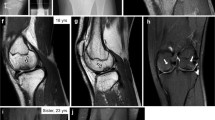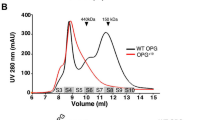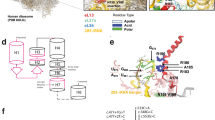Abstract
Pseudoachondroplasia (PSACH) is a well characterized dwarfing condition mapping to chromosome 19p12–13.1. Cartilage oligomeric matrix protein (COMP), a cartilage specific protein, maps to the same location within a contig that spans the PSACH locus. Using single strand conformation polymorphism (SSCP) analysis and nucleotide sequencing we have identified COMP mutations in eight familial and isolated PSACH cases. All mutations involve either a single base–pair change or a three base–pair deletion in exon 17B. Six mutations delete or change a well conserved aspartic acid residue within the calcium–binding type 3 repeats. These results demonstrate that mutations in the COMP gene cause pseudochondroplasia.
This is a preview of subscription content, access via your institution
Access options
Subscribe to this journal
Receive 12 print issues and online access
$209.00 per year
only $17.42 per issue
Buy this article
- Purchase on Springer Link
- Instant access to full article PDF
Prices may be subject to local taxes which are calculated during checkout
Similar content being viewed by others
References
Wynne-Davies, R., Hall, C.M. & Young, I.D. Pseudoachondroplasia: clinical diagnosis at different ages and comparison of autosomal dominant and recessive types. A review of 32 patients (26 kindred). J. med. Genet. 23, 425–434 (1986).
Spranger, J.W., Langer, Jr., L.O. & Wiedemann, H.-R. Bonedysplasia: an atlas of constitutional disorders of skeletal development. (W.B. Saunders, Philadelphia, 1974).
Hecht. J.T. et al. Linkage of typical pseudoachondroplasia to chromosome 19. Genomics 18, 661–666 (1993).
Briggs, M.D. et al. Genetic linkage of pseudoachondroplasia to markers in the pericentric region of chromosome 19. Genomics 18, 656–660 (1993).
Newton, G. et al. Characterization of human and mouse cartilage oligomeric matrix protein. Genomics 24, 435–439 (1994).
Adams, J. & Lawler, J. The thrombospondin family. Curr. Biol. 3, 188–190 (1993).
Bornstein, P., Thrombospondins:Structure and regulation of expression. FASEB J. 6, 3290–3299 (1992).
Lawler, J. Thrombospondins. in Molecular Basis of Thrombosis and Hemostasis. (eds High, K.A. & Roberts, H.R.) (Marcel Dekker, New York, 1995).
Sage, H. & Bornstein, P. Extracellular proteins that modulate cell-matrix interactions: SPARC, tenascin and thrombospondin. J. biol. Chem. 266, 14831–14834 (1991).
Hedbom, E. et al. Cartilage matrix proteins. An acidic oligomeric protein (COMP) detected only in cartilage. J. biol. Chem. 267, 6132–6136 (1992).
Morgelin, M., Heinegard, D., Engel, J. & Paulsson, M. Electron microscopy of native oligomeric matrix protein purified from the swarm ratchondrosarcoma reveals a five-armed structure. J. biol. Chem. 267, 6137–6141 (1992).
Oldberg, A., Antonsson, P., Lindblom, K. & Heinegard, D. COMP (Cartilage oligomeric matrix protein) is structurally related to the thrombospondins. J. biol. Chem. 267, 22346–22350 (1992).
DiCesare, P.E., Morgelin, M., Mann, K. & Paulsson, M. Cartilage oligomeric matrix protein and thrombospondin-1: Purification from articular cartilage electron microscopic structure and chondrocyte binding. Eur. J. Biochem. 223, 927–937 (1994).
Bornstein, P., Devarayalu, S., Edelhoff, S. & Disteche, C.M. Isolation and characterization of the mouse thrombospondin 3 (THBS3) gene. Genomics 15, 607–613 (1993).
Knowlton, R.G. et al. Precise localization of multiple epiphyseal dysplasia and pseudoachondroplasia mutations by genetic and physical mapping of chromosome 19. Am. J. hum. Genet. 55, A190, 1106 (1994).
Kretsinger, R.H. raphic studies of calmodulin and homologs. Proc. natn. Acad. Sci. U.S.A. 356, 14–19, (1980).
Lawler, J. & Simons, E. Cooperative binding of calcium to thrombospondin-1. J. biol. Chem. 258, 12098–12101 (1983).
Misenheimer, T.H. & Mosher, D.F. Calcium ion binding to thrombospondin 1. J. biol. Chem. 270, 1729–1733, (1995).
Heinegard, D. & Oldberg, A. Glycosolated Matrix Proteins. in Connective Tissue and Its Heritable Disorders 189–209 (Wiley-Liss, New York, 1993).
Stanescu, R., Stanescu, V., Muriel, M.-P. & Maroteaux, P. Multiple epiphyseal dysplasia, Fairbank type: Morphologic and biochemical study of cartilage. Am. J. med. Genet. 45, 501–507 (1993).
Stanescu, V., Do, T.P., Chaminade, F., Maroteaux, P. & Stanescu, R. Non-collagenous protein screening in the human chondrodysplasias: link proteins, cartilage oligomeric matrix protein (COMP), and fibromodulin. Am. J. hum. Genet. 51, 22–28 (1994).
Pedrini-Mille, A., Maynard, J.A. & Pedrini, V.A. Pseudoachondroplasia: biochemical and histochemical studies of cartilage. J. Bone Jt. Surg. 66A, 1408–1414 (1984).
Maynard, J.A., Cooper, R.R. & Poinsetti, I.V. A unique rough surfaced endoplasmic reticulum inclusion in pseudoachondroplasia. Lab. Invest. 26, 40–44 (1972).
Ellard, J.T. et al. Comparative studies of in vivo and in vitro human chondrocytes. Texas Soc. elec. Microsc., abstract, (1989).
Cooper, R.R., Poinsetti, I.V. & Maynard, J.A. Pseudoachondroplastic dwarfism. A rough surfaced endoplasmic reticulum storage disorder. J. Bone Jt. Surgery 55A, 475–484 (1973).
Finkelstein, J.E. et al. Analysis of the chondroitin sulfate proteoglycan core protein (CSPGCP) gene in achondroplasia and pseudoachondroplasia. Am. J. hum. Genet. 48, 97–102 (1991).
Hecht, J.T. et al. Exclusion of human proteoglycan link protein (CRTL1) and type II collagen (COL2A1) genes in pseudoachondroplasia. Am. J. hum. Genet. 44, 420–424 (1992).
Qabar, A.N. et al. Thrombospondin-3 is a developmentally regulated heparin binding protein. J. biol. Chem. 269, 1262–1269 (1994).
Guo, N.-H., Krutzsch, H.C., Negre, E., Zabrenetzky, V.S. & Roberts, D.D. Heparin-binding peptides from the type 1 repeats of thrombospondin: Structural requirements for heparin binding and promotion of melanoma cell adhesion and chemotaxis. J. biol. Chem. 267, 19349–19355 (1992).
Lawler, J., Ferro, P. & Duquette, M. Expression and mutagenesis of thrombospondin. Biochemistry 31, 1173–1180 (1992).
Prockop, D.J. Osteogenesis Imperfecta:Phenotypic heterogeneity, protein suicide, short and long collagen. Am. J. hum. Genet. 36, 499–505 (1984).
Jacenko, O., LuValle, P.A., Olsen, B.R. Spondylometaphyseal dysplasia in mice carrying a dominant negative mutation in a matrix protein specific for cartilage-to-bone transition. Nature 365, 56–61 (1993).
Gelliss, S.S. & Feingold, M. Pseudoachondroplasia(pseudoachondroplastic spondyloepiphyseal dysplasia). Am. J. Dis. Child. 128, 833–834 (1974).
Hall, J.G., Dorst, J.P., Rotta, J. & McKusick, V.A. Gonadal mosaicism in pseudoachondroplasia. Am. J. hum. Genet. 28, 143–151 (1987).
Mewar, R., Harrison, W. & Overhauser, J. Confirmation of isochromosome 18p using whole chromosome arm-specific fluorescence in situ hybridization. Cytogenet. Cell Genet. 64, 1–4 (1993).
Sambrook, J., Fritsch, F. & Maniatis, T. Molecular cloning. A laboratory manual, 2nd edn (Cold Spring Harbor Laboratory Press, Cold Spring Harbor, 1989).
Author information
Authors and Affiliations
Rights and permissions
About this article
Cite this article
Hecht, J., Nelson, L., Crowder, E. et al. Mutations in exon 17B of cartilage oligomeric matrix protein (COMP) cause pseudoachondroplasia. Nat Genet 10, 325–329 (1995). https://doi.org/10.1038/ng0795-325
Received:
Accepted:
Issue Date:
DOI: https://doi.org/10.1038/ng0795-325
This article is cited by
-
Clinical, Biochemical, Radiological, Genetic and Therapeutic Analysis of Patients with COMP Gene Variants
Calcified Tissue International (2022)
-
Mutations in COMP cause familial carpal tunnel syndrome
Nature Communications (2020)
-
Direct, gabapentin-insensitive interaction of a soluble form of the calcium channel subunit α2δ-1 with thrombospondin-4
Scientific Reports (2019)
-
Dual novel mutations in SLC26A2 in two siblings with multiple epiphyseal dysplasia 4 from a Chinese family: a case report
BMC Medical Genetics (2018)
-
Two novel mutations of COMP in Japanese boys with pseudoachondroplasia
Human Genome Variation (2018)



